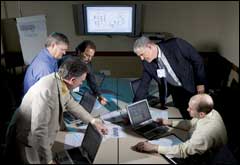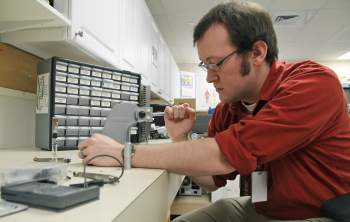 |
| From left, David W. Braeutigam, director, biomedical engineering; Wayne Shaver, manager, biomedical engineering; Richard Swim, technology manager; Kenneth E. Maddock, corporate director, biomedical technology services; and Daniel Irving, biomedical manager. |
When comparing biomedical departments, job descriptions and titles are often similar—it’s in the details where differences really shine. For the team of biomeds working within the Baylor Health Care System, Dallas, the uniqueness starts with the organizational chart.
The biomedical technology services department, which includes imaging and biomedical equipment techs, reports to a vice president in information services (IS). The decision was made, in part, as a response to the growing number of networking connections required to interface medical equipment to hospital information systems.
“Our CIO at the time envisioned this as a way of taking the final step to the bedside, particularly because at that time we were beginning to move in the direction of an electronic health record,” says Kenneth E. Maddock, corporate director of Baylor’s biomedical technology services, Baylor Health Care System. While logical, administrators were well aware that IS can often be at odds with the biomedical teams. Maddock’s answer to that issue is, “If you’re going to be successful as a biomed, you have got to care about more than just being a good biomed; you really have to care about health care. The gray areas of whose responsibility is what aren’t going to completely go away, and that’s okay—it’s how you deal with the gray areas that is important.
“The bottom line is how you resolve those problems,” Maddock continues. “Do you just hand off work and responsibilities to the next guy, or do you work with them and say let’s figure this out together? We’re committed to working with our peers in IS to provide our customers with the best possible service.”
 |
By the Horns
That proactive approach in tending to medical equipment has manifested in two individual performance teams—the preventive maintenance process improvement team and the customer service initiative team—which Maddock established since joining the organization in 2003.
“There are a lot of things that we can impact as biomeds, and from an operational standpoint, one of the biggest things is preventing equipment from failing,” he says. “And to do this, I believe people have to adjust their definition of a preventive maintenance (PM) program.”
Maddock believes the priority should be less on how often PMs are completed and which systems receive scheduled maintenance and more on preventing failures, regardless of what that takes.
“One of the goals is to free up your time to do the work that is really critical, even scheduled work,” says Richard Swim, CLES, MCSE, technology manager, biomedical technology services, who heads up the preventive maintenance process improvement team. “If you’re doing fruitless inspections that can be eliminated, or if the frequency of those inspections can be stretched out, then it gives you time to work on the more demanding projects.”
Establishing which systems truly require more time is an in-depth process that starts with analyzing the database of work orders. By identifying what types of calls are coming in, as well as what modalities or equipment are failing the most, the biomeds can focus their attention most appropriately.
“If we can identify a pattern to the types of unscheduled service calls coming through, we can determine what we can do from the scheduled maintenance side to cut down on the number of those calls in the future,” Swim says. “We’re operating under the general philosophy that if we can stay on top of a failure, then the clinical staff is going to experience far less unscheduled downtime.”
This may mean that a biomed’s visits will increase for some systems and decrease for others. For example, when a digital electrocardiogram monitor is plugged into a simulator, it either functions properly or it doesn’t. Constantly checking the machine is fruitless and consumes valuable tech time.
“Some people believe it doesn’t matter if we never see a problem, that certain high-risk equipment requires inspections regardless. But my belief is, it doesn’t matter how high-risk it is if every time you do a check you find out the same data—and you can use your data to demonstrate that. Then you should ask yourself what you are gaining by performing that check,” says Maddock, who does not discount the value of rounds in which the tech searches for signs of unreported trouble even if formal PMs are discontinued. “You can’t be ruled by your heart. The bottom line is, if something you’re doing does not offer value, stop doing it. You have to improve all the time. If you’re not getting better, then you’re falling behind.”
A New Type of CSI
Similarly, Baylor’s customer service initiative (CSI) team looks at delivering optimal care to clinicians by closing as many work orders as possible on the same day they are opened, and decreasing the turnaround time for calls that can’t be completed on the first day.
“Currently, we complete about 80% of the calls we get on the first day,” says Wayne Shaver, BBA, CBET, who oversees the CSI team and is manager of biomedical engineering, biomedical technology services. “Rather than just looking at system failures and determining which, if any, can be taken care of proactively with PMs, we look at the types of failures and what can be done to increase first-visit repair rates.”
Such solutions include adjusting the exact parts kept on hand to ensure the most demanded are available, when possible. It can also include working with the PM team in adjusting the testing of certain systems, in an effort to catch malfunctions before they occur.
Making this happen requires some number crunching to identify the types of malfunctions the team sees most, as well as what is feasible in terms of an on-the-spot remedy.
“We have five senior BMETs on this team, and we are working to maintain representation from several campuses. When we meet, we discuss what kind of equipment problems we are having and focus on the critical devices first,” Shaver says. “We also analyze what kind of failures we see, then come up with actions we can take to minimize those failures.”
Shaver and the team realize there are some factors that force certain projects onto subsequent days, such as waiting for a vendor to arrive, triaging another job as a higher priority, and waiting for delivery of parts too expensive to be kept on hand. In some cases it is as simple as not having immediate access to the device. Still, their commitment to same-day turnaround is strong.
“We need to keep the equipment in operational condition at all times when possible, because it improves overall morale,” Shaver says. “If the clinical staff needs something, in their minds it’s a high priority. If you can get the machine fully functional again and minimize the downtime, then you’ve improved satisfaction all the way around.”
Making Life Easier
Juggling an ever growing list of work orders can be a daunting task for even the most seasoned biomed tech. The crew at Baylor has addressed this challenge by putting technology to work for them.
“I developed a number of queries inside of our database that are sent out via e-mail directly from the database,” Swim says. One report every biomed receives is a list of his or her outstanding work orders. “A work order query goes out every morning, giving a snapshot of that tech’s active work orders. And in this alert is a hyperlink that links to the database and opens the corresponding work order. If techs look at the e-mail and want to go straight to that work order to do some documentation on it, they just click on the link, and it launches at their workstation.”
By sending out topic-specific e-mails, the automated alert system also helps managers keep an eye on their scheduled inspections. In addition, it gives a list of how many orders are sitting in the respective queues of their techs, allowing a birds-eye view of the team’s overall workload.
“We know that people are going to forget to do things, so we are trying to make it easy for them where we can and send tools to them to help them get their work done,” Maddock says. Because the queries are coded by Swim, they can be as specific and as numerous as needed. “We try not to overwhelm people with them, but they have really made a difference. For instance, where we can, we have programmed a search that corrects some data entry errors automatically, because it’s more efficient that way.”
It also helps with compliance issues, such as The Joint Commission’s increasing focus on the maintenance of life-support equipment.
“Typically, life-support equipment is defined as ventilators, defibs, heart-lung bypass units, intra-aortic balloon pumps. It’s not really that much equipment, but you have to make sure it is getting checked,” says David W. Braeutigam, MBA, CBET, director of biomedical engineering, biomedical technology services. “To help make sure this is getting done, we set up e-mail alerts for the managers and lead tech from each site, which lists the life-support equipment for which a scheduled maintenance work order hasn’t been closed in 21 days. It doesn’t mean it’s past due, but it lets them know that the deadline is approaching.”
Group Effort
This drive by the Baylor team to improve the organizational process, as well as themselves individually, fits in with Maddock’s vision for his department, and for the industry as a whole.
|
Read other department profiles in past issues of 24×7 in our online archives. |
 |
“If the biomedical field is going to survive, we have to find a way to not worry about surviving,” Maddock says. “Our focus has to be on how we can work together with everybody on the team—and we really do act as a team—to further our organization and to further health care.”
Dana Hinesly is a contributing writer for 24×7. For more information, contact .




